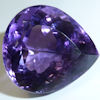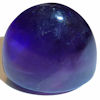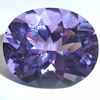
Amethyst is just one of many Quartz varieties, but arguably the most popular. It is the birthstone for February, the designated gem for the 6th Anniversary, and as the Greek word’s meaning implies, it is worn to prevent drunkenness. It is one of the few truly purple gems and that color is the sole distinction between it and other Quartz varieties. Any crystalline purple Quartz is Amethyst, although other varieties of Quartz derive from Amethyst through treatments such as Citrine (yellow) and Prasiolite (green).
Amethyst is found nearly everywhere, but the most prolific deposits are Brazil, Zambia and Uruguay. These deposits have proven to be so massive that good quality material is abundant and relatively inexpensive. Material with a rich purple color with red and/or blue flashes is particularly sought after and larger gems of this type demand the highest prices. Lower quality material is made into beads, cabochons, carved or left in crystal clusters for beautiful display pieces. Large pockets of this material are often preserved and amazing natural cathedrals of crystals can be found up to 25ft high or more. Heated Amethyst produces another popular Quartz variety called Citrine. Natural Citrine is rare but available and the unusual combination of these two varieties is called Ametrine.
Although natural Amethyst is inexpensive, synthetic Amethyst is still produced and is abundant. Although it may be difficult to distinguish smaller pieces of natural material from the synthetic, there are some telltale signs to look for in parcels and larger gems. First, natural Amethyst is nearly always color zoned to some degree, while synthetics rarely show any color zoning. Second, synthetic material is nearly always free of inclusions. Natural material is also often eye clean, but if examined closely with 10x loupe, some evidence of natural inclusions can usually be found. Other imitations such as CZ or glass are easily noticed by their color and hue differences, but are also easily identified with a simple Refractive Index test.





